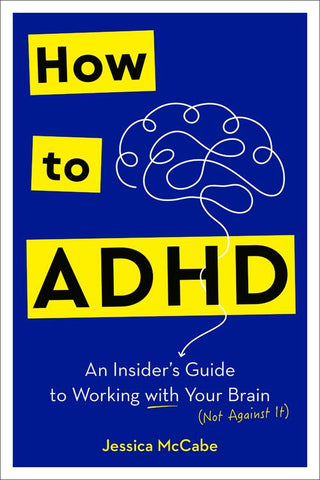In this honest, friendly, and shame-free guide, the creator of the award-winning YouTube channel How to ADHD shares the hard-won insights and practical strategies that have helped her survive, even thrive, in a world not built for her brain.
Forget “try harder.” When your brain works differently, you need to try different .
Diagnosed with ADHD at age twelve, Jessica struggled with a brain that she didn’t understand. She lost things constantly, couldn’t finish projects, and felt like she was putting more effort in than everyone around her while falling further and further behind. At thirty-two years old—broke, divorced, and living with her mom—Jessica decided to look more deeply into her ADHD challenges. She reached out to experts, devoured articles, and shared her discoveries on YouTube.
In How to ADHD , Jessica reveals the tools that have changed her life while offering an unflinching look at the realities of living with ADHD. The key to navigating a world not built for the neurodivergent brain, she discovered, isn’t to fix or fight against its natural tendencies but to understand and work with them. She explains how ADHD affects everyday life, covering executive function impairments, rejection sensitivity, difficulties with attention regulation, and more. You’ll also find ADHD-specific strategies for adapting your environment, routines, and systems,
• Boost the signal and decrease the noise . Facilitate focus by putting your goals where you can see them and fighting distractions with distractions.
• Have less stuff to manage. Learn why you have trouble planning and prioritizing, and why doing more starts with doing less.
• Build your “time wisdom.” Work backward when you plan, and track how long it actually takes you to do something.
• Learn about your emotions. Understand how naming your emotions and letting yourself experience them can make them easier to regulate.
With quotes from Jessica’s online community, chapter summaries, and reading shortcuts designed for the neurodivergent reader, How to ADHD will help you recognize your strengths and challenges, tackle “bad brain days,” and be kinder to yourself in the process.
Forget “try harder.” When your brain works differently, you need to try different .
Diagnosed with ADHD at age twelve, Jessica struggled with a brain that she didn’t understand. She lost things constantly, couldn’t finish projects, and felt like she was putting more effort in than everyone around her while falling further and further behind. At thirty-two years old—broke, divorced, and living with her mom—Jessica decided to look more deeply into her ADHD challenges. She reached out to experts, devoured articles, and shared her discoveries on YouTube.
In How to ADHD , Jessica reveals the tools that have changed her life while offering an unflinching look at the realities of living with ADHD. The key to navigating a world not built for the neurodivergent brain, she discovered, isn’t to fix or fight against its natural tendencies but to understand and work with them. She explains how ADHD affects everyday life, covering executive function impairments, rejection sensitivity, difficulties with attention regulation, and more. You’ll also find ADHD-specific strategies for adapting your environment, routines, and systems,
• Boost the signal and decrease the noise . Facilitate focus by putting your goals where you can see them and fighting distractions with distractions.
• Have less stuff to manage. Learn why you have trouble planning and prioritizing, and why doing more starts with doing less.
• Build your “time wisdom.” Work backward when you plan, and track how long it actually takes you to do something.
• Learn about your emotions. Understand how naming your emotions and letting yourself experience them can make them easier to regulate.
With quotes from Jessica’s online community, chapter summaries, and reading shortcuts designed for the neurodivergent reader, How to ADHD will help you recognize your strengths and challenges, tackle “bad brain days,” and be kinder to yourself in the process.
In this honest, friendly, and shame-free guide, the creator of the award-winning YouTube channel How to ADHD shares the hard-won insights and practical strategies that have helped her survive, even thrive, in a world not built for her brain.
Forget “try harder.” When your brain works differently, you need to try different .
Diagnosed with ADHD at age twelve, Jessica struggled with a brain that she didn’t understand. She lost things constantly, couldn’t finish projects, and felt like she was putting more effort in than everyone around her while falling further and further behind. At thirty-two years old—broke, divorced, and living with her mom—Jessica decided to look more deeply into her ADHD challenges. She reached out to experts, devoured articles, and shared her discoveries on YouTube.
In How to ADHD , Jessica reveals the tools that have changed her life while offering an unflinching look at the realities of living with ADHD. The key to navigating a world not built for the neurodivergent brain, she discovered, isn’t to fix or fight against its natural tendencies but to understand and work with them. She explains how ADHD affects everyday life, covering executive function impairments, rejection sensitivity, difficulties with attention regulation, and more. You’ll also find ADHD-specific strategies for adapting your environment, routines, and systems,
• Boost the signal and decrease the noise . Facilitate focus by putting your goals where you can see them and fighting distractions with distractions.
• Have less stuff to manage. Learn why you have trouble planning and prioritizing, and why doing more starts with doing less.
• Build your “time wisdom.” Work backward when you plan, and track how long it actually takes you to do something.
• Learn about your emotions. Understand how naming your emotions and letting yourself experience them can make them easier to regulate.
With quotes from Jessica’s online community, chapter summaries, and reading shortcuts designed for the neurodivergent reader, How to ADHD will help you recognize your strengths and challenges, tackle “bad brain days,” and be kinder to yourself in the process.
Forget “try harder.” When your brain works differently, you need to try different .
Diagnosed with ADHD at age twelve, Jessica struggled with a brain that she didn’t understand. She lost things constantly, couldn’t finish projects, and felt like she was putting more effort in than everyone around her while falling further and further behind. At thirty-two years old—broke, divorced, and living with her mom—Jessica decided to look more deeply into her ADHD challenges. She reached out to experts, devoured articles, and shared her discoveries on YouTube.
In How to ADHD , Jessica reveals the tools that have changed her life while offering an unflinching look at the realities of living with ADHD. The key to navigating a world not built for the neurodivergent brain, she discovered, isn’t to fix or fight against its natural tendencies but to understand and work with them. She explains how ADHD affects everyday life, covering executive function impairments, rejection sensitivity, difficulties with attention regulation, and more. You’ll also find ADHD-specific strategies for adapting your environment, routines, and systems,
• Boost the signal and decrease the noise . Facilitate focus by putting your goals where you can see them and fighting distractions with distractions.
• Have less stuff to manage. Learn why you have trouble planning and prioritizing, and why doing more starts with doing less.
• Build your “time wisdom.” Work backward when you plan, and track how long it actually takes you to do something.
• Learn about your emotions. Understand how naming your emotions and letting yourself experience them can make them easier to regulate.
With quotes from Jessica’s online community, chapter summaries, and reading shortcuts designed for the neurodivergent reader, How to ADHD will help you recognize your strengths and challenges, tackle “bad brain days,” and be kinder to yourself in the process.

